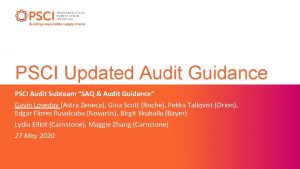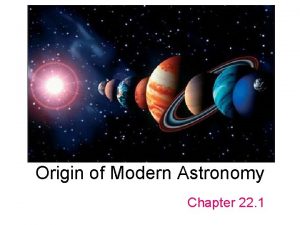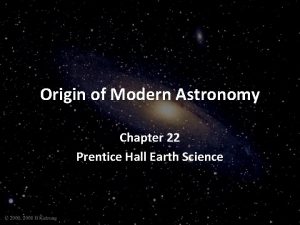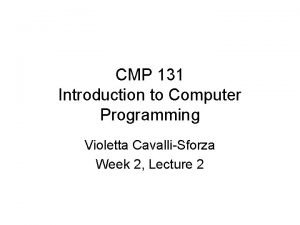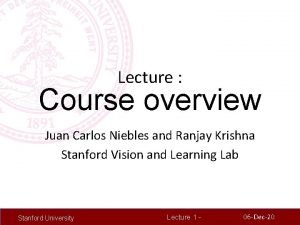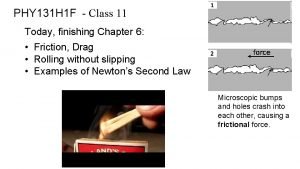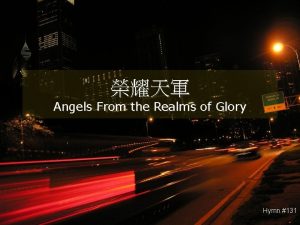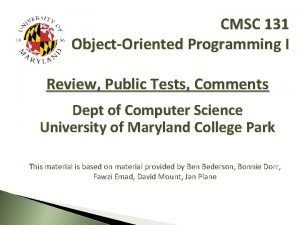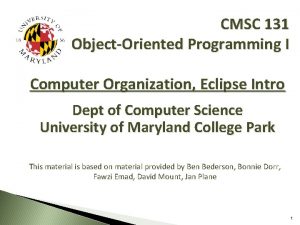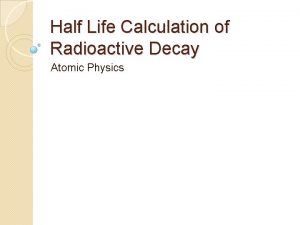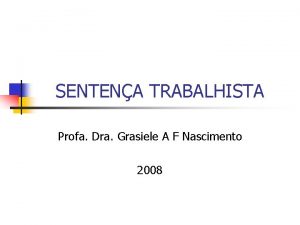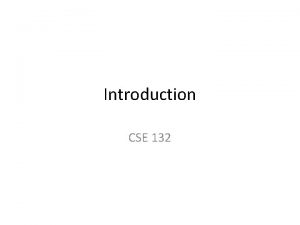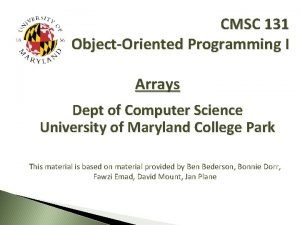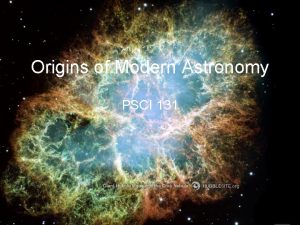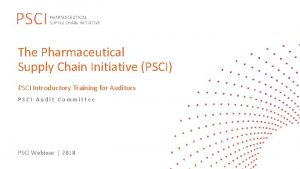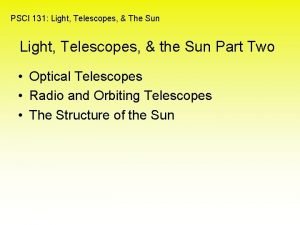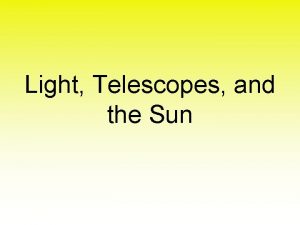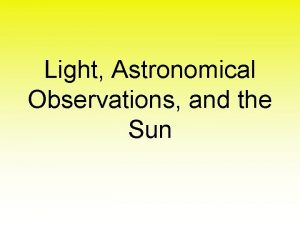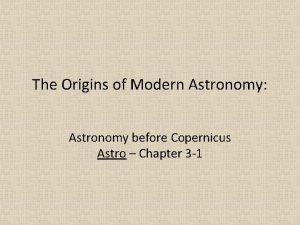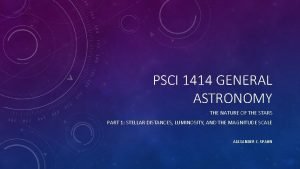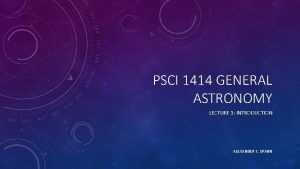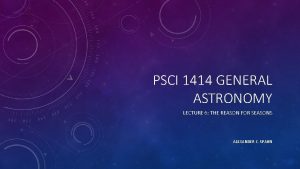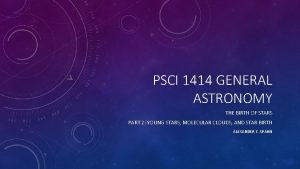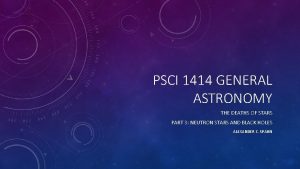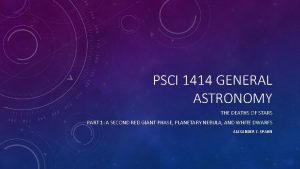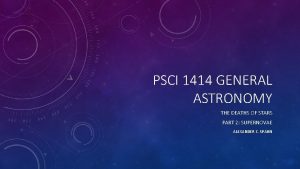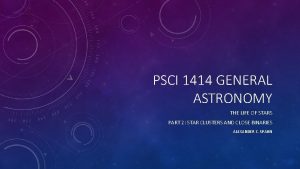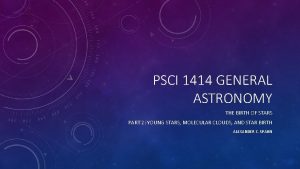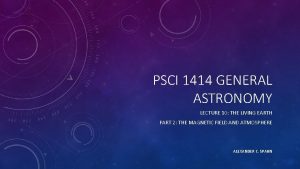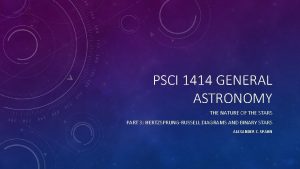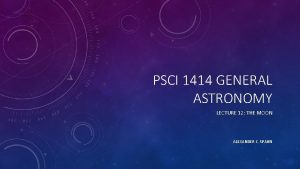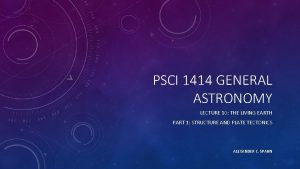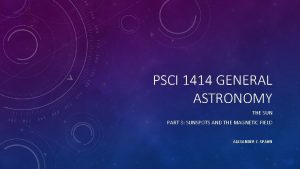Origins of Modern Astronomy PSCI 131 ORIGINS OF



























- Slides: 27

Origins of Modern Astronomy PSCI 131

ORIGINS OF ASTRONOMY • • Patterns in the Night Sky Our Solar System Earth Motions Earth-Moon System

Patterns in the Night Sky • Constellation – named pattern (or grouping) of stars • 88 known constellations • The brightest stars in each constellation are named in order of their brightness. – Use the Greek alphabet. • Alpha, beta, etc.

Question • Name as many constellations as you can. • Which constellation is the North Star (Polaris) located in?

Patterns in the Night Sky • All of the stars look equally far away so the ancient Greeks positioned the stars inside a “celestial sphere” that surrounds the earth. • In reality, a star’s brightness is dependent on its distance from us and its actual brightness. HR Diagram

Our Solar System

What Does Our Solar System Look Like?

Planet Radius (km) Density (g/cm 3) Atmosphere Composition Rings Surface Mercury 244000 5. 4 Faint atmosphere – Oxygen, Sodium, Magnesium, others No Solid – Rocky Venus 610000 5. 2 Carbon Dioxide (97%), Nitrogen (3%) No Solid – Rocky Earth 640000 5. 5 Nitrogen (78%), Oxygen (21%), Water Vapor (1%) No Solid – Rocky Mars 340000 4. 0 Thin atmosphere – Carbon Dioxide (95%), Nitrogen (3%), Argon (2%) No Solid – Rocky Jupiter 7100000 1. 3 Hydrogen (89%), Helium (10%) Yes Gas Saturn 6000000 0. 63 Hydrogen (96%), Helium (3%) Yes Gas Uranus 2600000 1. 2 Hydrogen (82%), Helium (15%), Methane (2%) Yes Gas Neptune 2500000 1. 5 Hydrogen (80%), Helium (19%), Methane (1%) Yes Gas Pluto 120000 1. 9 Thin Atmosphere - Nitrogen (90%), Methane (10%) No Solid – Rocky/Ice Eris 116000 2. 52 Faint atmosphere – Nitrogen and Methane No Solid – Rocky/Ice


Nebular Theory • Sun and planets cooled from a cloud of rotating interstellar gases – Composition of planets depends on proximity from sun • Mercury, Venus, Earth, Mars – Materials with high melting temperature (metals/rock) – Collisions and accretion formed four protoplanets that eventually became the terrestrial planets • Jupiter, Saturn, Uranus, Neptune – Gases condensed into ices (water vapor, carbon dioxide, ammonia, methane) – Large size, low density became Jovian planets

PSCI 131: Origins of Astronomy –Earth Motions

PSCI 131: Origins of Astronomy –Earth Motions Rotation • Solar day – Time from noon on one day to noon the next day: 24 hours • Time required for the Sun to return to the same position on two successive nights • Sidereal day – Time required for the “fixed” stars to return to the same position on two successive nights: 23 hrs 56 minutes

PSCI 131: Origins of Astronomy –Earth Motions Revolution • Period of revolution: 365. 25 days – Leap year (every 4 th year) – Earth travels around Sun at 107, 000 km per hour • Perihelion: closest to Sun (January) – 147 million km • Aphelion: farthest from Sun (July) – 152 million km

PSCI 131: Origins of Astronomy –Earth Motions Revolution: Solstices & equinoxes Solstice – Sun directly overhead at either Tropic of Cancer or Tropic of Capricorn • Summer solstice - June 21 st • Winter solstice - December 21 st Equinox – Sun’s rays are directly above the equator • Vernal Equinox - March 20 th • Autumnal Equinox - September 22 nd

PSCI 131: Origins of Astronomy –Earth Motions Precession • Wobble of Earth on its axis; 26, 000 -yr cycle

GEOL 131: Glaciers: Causes of Ice Ages Orbital variations: Obliquity • Tilt angle of rotational axis • 41, 000 -year cycle

GEOL 131: Glaciers: Causes of Ice Ages Orbital variations: Eccentricity • Shape of orbit • 100, 000 -year cycle

PSCI 131: Origins of Astronomy –Earth-Moon System The Earth-Moon System

PSCI 131: Origins of Astronomy –Earth-Moon System The Earth-Moon System • Mean Earth-Moon distance: ~238, 000 mi • Period of rotation: 27. 5 days • Period of revolution: 27. 5 days • “Synchronous” orbit – Same side always faces Earth

The Moon • • About ¼ of Earth’s diameter (2160 km) 225 deg F during day, -243 deg F at night 3. 3 x as dense as water Small mass and low gravity means there is no atmosphere.

PSCI 131: Origins of Astronomy –Earth-Moon System Lunar Phases • Half of lunar surface always lit – Exception: lunar eclipse • Current phase depends on how much of lit surface is visible from Earth

PSCI 131: Origins of Astronomy – Earth-Moon System-Lunar Phases

Eclipses

Solar Eclipse • During new moon • Moon casts shadow on earth – Occurs approx. once every 18 months somewhere on the Earth • Umbra – zone of total eclipse • Penumbra – zone of partial eclipse

Lunar Eclipse • During full moon • Moon in earth’s shadow • Umbra • Penumbra

Eclipses • Why don’t we have eclipses every new and full moon? – Moon’s orbit is tilted with respect to the ecliptic

PSCI 131: Origins of Astronomy End of Origins of Astronomy
 Learning astronomy by doing astronomy activity 7 answers
Learning astronomy by doing astronomy activity 7 answers Learning astronomy by doing astronomy activity 1 answers
Learning astronomy by doing astronomy activity 1 answers Learning astronomy by doing astronomy
Learning astronomy by doing astronomy Pharmaceutical supply chain initiative
Pharmaceutical supply chain initiative Psci audit
Psci audit Pharmaceutical supply chain initiative psci
Pharmaceutical supply chain initiative psci Chapter 22 origin of modern astronomy answer key
Chapter 22 origin of modern astronomy answer key Chapter 22.2 origin of modern astronomy answer key
Chapter 22.2 origin of modern astronomy answer key Violetta cavalli sforza
Violetta cavalli sforza Phy 131 past papers
Phy 131 past papers Ranjay krishna
Ranjay krishna 131 h
131 h Hmn 131
Hmn 131 Cmsc 131
Cmsc 131 Cmsc 131
Cmsc 131 Hbu 115 uitm
Hbu 115 uitm Buderus schulung
Buderus schulung Radioactive decay of iodine 131
Radioactive decay of iodine 131 Art. 131 cpc
Art. 131 cpc Cse 131
Cse 131 Could 131g of xenon gas in a vessel
Could 131g of xenon gas in a vessel Cmsc 131
Cmsc 131 Kristin spent $131 on shirts answers
Kristin spent $131 on shirts answers Psalm 131 vers 4
Psalm 131 vers 4 Phy 121 asu
Phy 121 asu Medical plaza miller 131 miller street
Medical plaza miller 131 miller street Psalm 131
Psalm 131 Apos 40 dias uma amostra com 1 6g de iodo 131
Apos 40 dias uma amostra com 1 6g de iodo 131




